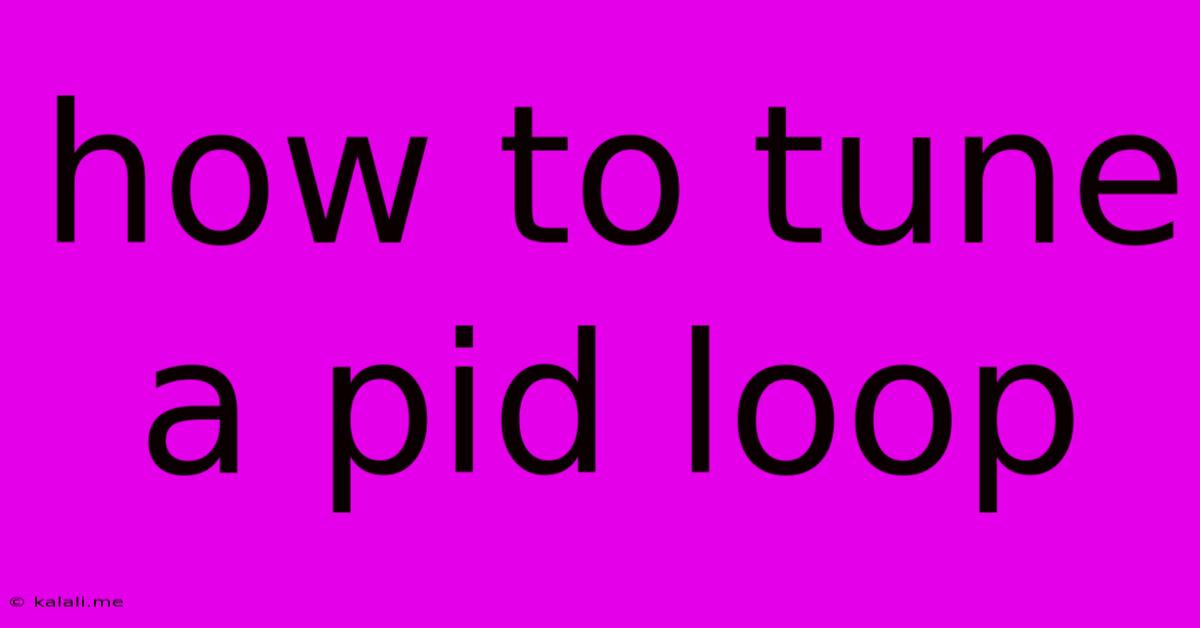How To Tune A Pid Loop
Kalali
May 23, 2025 · 3 min read

Table of Contents
How to Tune a PID Loop: A Comprehensive Guide
Meta Description: Learn how to effectively tune a PID loop for optimal control system performance. This guide covers the basics of PID controllers, tuning methods like Ziegler-Nichols, and troubleshooting common issues. Master the art of PID tuning and achieve precise control.
PID controllers are ubiquitous in automation and control systems, used to regulate everything from temperature and motor speed to chemical processes and robotic arms. However, getting a PID loop to perform optimally requires careful tuning. This comprehensive guide will walk you through the process, explaining the fundamental principles and providing practical tuning methods.
Understanding PID Control
A PID controller uses three terms to adjust a control system's output:
-
Proportional (P): This term reacts to the current error (difference between the desired setpoint and the actual value). A larger error results in a larger corrective action. The proportional gain (Kp) determines the strength of this response.
-
Integral (I): This term addresses persistent errors. It accumulates the error over time, providing a corrective action even if the error is small but consistent. The integral gain (Ki) controls the rate of this accumulation.
-
Derivative (D): This term anticipates future errors by considering the rate of change of the error. It dampens oscillations and speeds up the response to sudden changes. The derivative gain (Kd) determines the sensitivity to this rate of change.
PID Tuning Methods
Several methods exist for tuning PID controllers. Two popular approaches are:
1. Ziegler-Nichols Method
This empirical method requires identifying two key parameters:
- Ultimate Gain (Ku): The maximum proportional gain (Kp) at which the system starts to oscillate continuously.
- Ultimate Period (Pu): The period of these sustained oscillations.
Once Ku and Pu are determined (often through experimentation), the PID gains are calculated using the following formulas:
- Kp = 0.6 * Ku
- Ki = 1.2 * Ku / Pu
- Kd = 0.075 * Ku * Pu
This method provides a starting point, and further fine-tuning might be necessary.
2. Trial and Error (Manual Tuning)
This method involves iteratively adjusting the PID gains, observing the system's response, and making adjustments based on the observed behavior.
- Start with only Proportional (P) gain: Increase Kp until the system starts to oscillate. Reduce Kp slightly to eliminate oscillations.
- Add Integral (I) gain: Introduce Ki to eliminate steady-state error. Start with a small value and gradually increase it until the error is minimized. Be cautious to avoid overshooting or instability.
- Add Derivative (D) gain: Introduce Kd to reduce overshoot and improve response time. Start with a small value and gradually increase it until optimal performance is achieved.
Troubleshooting Common PID Issues
-
Overshoot: The system output exceeds the setpoint before settling. Reduce Kp and/or Kd.
-
Undershoot: The system output fails to reach the setpoint. Increase Kp and/or Ki.
-
Oscillations: The system output fluctuates around the setpoint. Reduce Kp and/or Kd. Increase Ki cautiously to improve stability.
-
Slow Response: The system takes too long to reach the setpoint. Increase Kp and/or Ki.
-
Offset (Steady-State Error): The system output doesn't reach the setpoint. Increase Ki.
Advanced PID Tuning Techniques
For more complex systems, advanced techniques like:
- Automatic Tuning Algorithms: Software-based tools automate the tuning process.
- Model Predictive Control (MPC): Uses a system model to predict future behavior and optimize control actions.
may be necessary to achieve optimal performance.
Conclusion
Tuning a PID loop effectively is crucial for achieving optimal control system performance. While the Ziegler-Nichols method provides a starting point, manual tuning often requires iterative adjustments and careful observation of system response. Understanding the roles of the P, I, and D gains, and addressing common issues, is essential for mastering PID control. Remember to always prioritize safety and monitor the system carefully during the tuning process.
Latest Posts
Latest Posts
-
Mother And I Or Mother And Me
Jul 18, 2025
-
How Many Oz In One Water Bottle
Jul 18, 2025
-
How Many Dimes In A 5 Roll
Jul 18, 2025
-
How Do You Say Basil In Spanish
Jul 18, 2025
-
How Many Cookies Are In A Dozen
Jul 18, 2025
Related Post
Thank you for visiting our website which covers about How To Tune A Pid Loop . We hope the information provided has been useful to you. Feel free to contact us if you have any questions or need further assistance. See you next time and don't miss to bookmark.